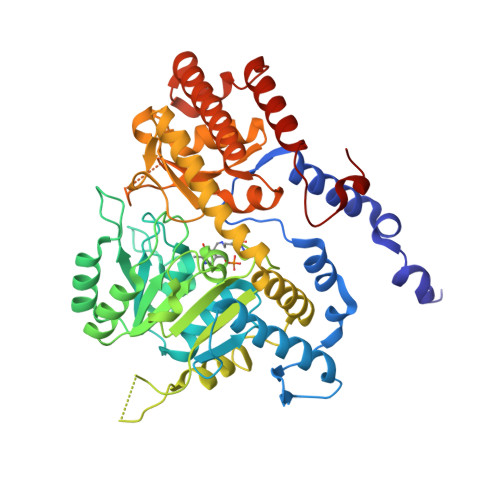Impaired folate binding of serine hydroxymethyltransferase 8 from soybean underlies resistance to the soybean cyst nematode.
Korasick, D.A., Kandoth, P.K., Tanner, J.J., Mitchum, M.G., Beamer, L.J.(2020) J Biological Chem 295: 3708-3718
- PubMed: 32014996
- DOI: https://doi.org/10.1074/jbc.RA119.012256
- Primary Citation of Related Structures:
6UXH, 6UXI, 6UXJ, 6UXK, 6UXL - PubMed Abstract:
Management of the agricultural pathogen soybean cyst nematode (SCN) relies on the use of SCN-resistant soybean cultivars, a strategy that has been failing in recent years. An underutilized source of resistance in the soybean genotype Peking is linked to two polymorphisms in serine hydroxy-methyltransferase 8 (SHMT8). SHMT is a pyridoxal 5'-phosphate-dependent enzyme that converts l-serine and (6 S )-tetrahydrofolate to glycine and 5,10-methylenetetrahydrofolate. Here, we determined five crystal structures of the 1884-residue SHMT8 tetramers from the SCN-susceptible cultivar (cv.) Essex and the SCN-resistant cv. Forrest (whose resistance is derived from the SHMT8 polymorphisms in Peking); the crystal structures were determined in complex with various ligands at 1.4-2.35 Å resolutions. We find that the two Forrest-specific polymorphic substitutions (P130R and N358Y) impact the mobility of a loop near the entrance of the (6 S )-tetrahydrofolate-binding site. Ligand-binding and kinetic studies indicate severely reduced affinity for folate and dramatically impaired enzyme activity in Forrest SHMT8. These findings imply widespread effects on folate metabolism in soybean cv. Forrest that have implications for combating the widespread increase in virulent SCN.
- Department of Biochemistry, University of Missouri, Columbia, Missouri 65211.
Organizational Affiliation:


















